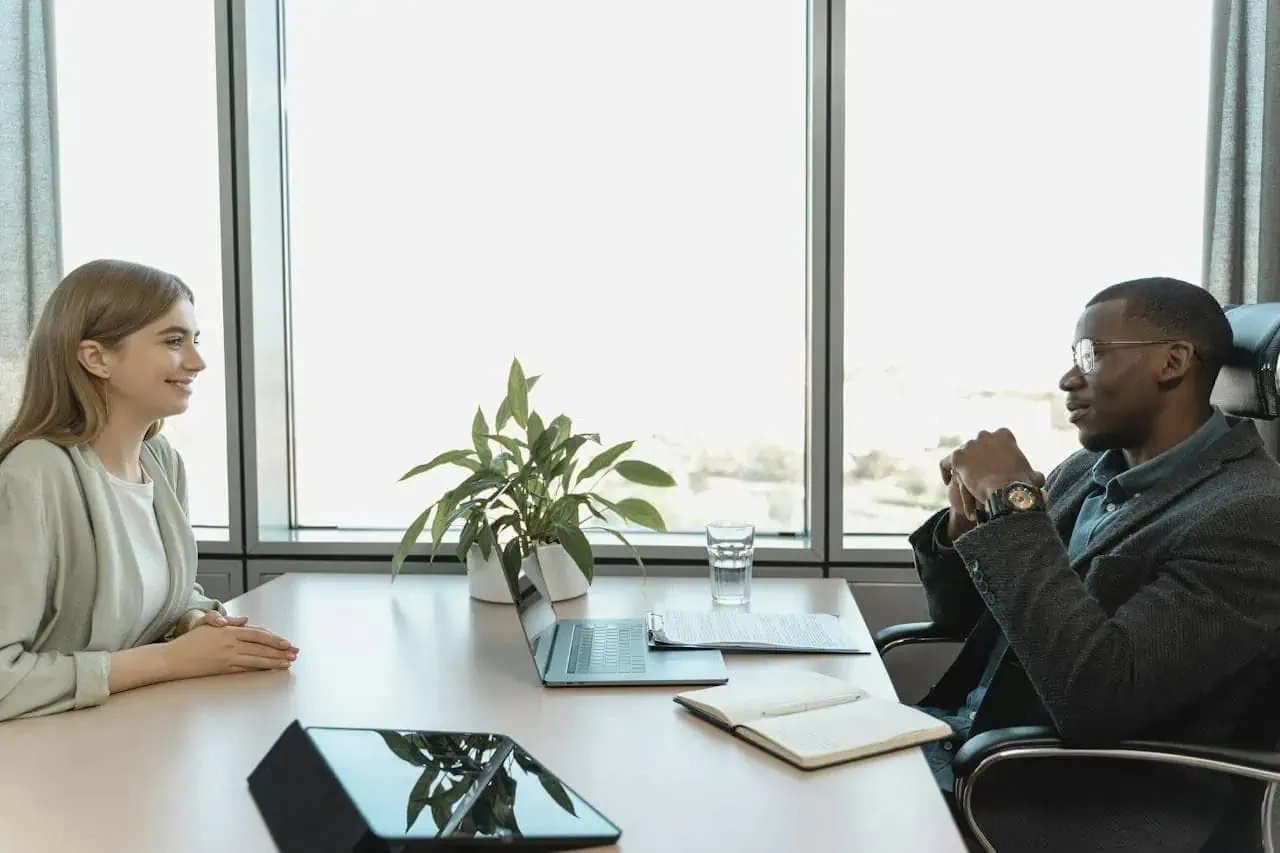Stepping into the job market can be daunting, especially for entry-level seekers. But, with the right approach, you can make a striking impression from the get-go. This guide, focusing on first-impression interview strategies, is your roadmap. Here, we dive into the power of body language, the art of small talk, and the importance of cultural sensitivity. These elements are crucial for making a solid first impression. So why is this important? In today’s diverse job market, standing out for the right reasons can make all the difference. Let’s get started on this journey together.
With these strategies, you’re not just preparing for interviews but setting the stage for career success. Ready to make a memorable first impression? Let’s dive in.
The Role of First Impressions
Making a great first impression in an interview is vital. This step decides how the rest of your meeting will unfold. It’s not just about what you say but how you come across. Some studies show that interviewers form their opinions in the first few minutes. So, the pressure is on from the moment you walk in. But don’t worry; with the right strategies, you can shine. We’ll focus on two main areas: Mastering Interview Body Language and Small Talk Interview Techniques.
First Impression Interview Strategies
First impressions are powerful. They set the tone for the entire interview. Good first impressions can:
- Boost your confidence.
- Make you memorable.
- Show you’re the right fit.
But it’s not just about impressing your interviewer. It’s also about feeling good about yourself. Your confidence soars when you know you’ve made a solid first impression. This, in turn, impacts how you handle the rest of the interview.
Beyond the personal benefits, making an excellent first impression is also about respecting the cultural and professional norms of the company. Understanding and applying cultural sensitivity becomes crucial, especially in a diverse job market.
According to the U.S. Department of Labor, understanding workplace dynamics and communication styles is essential for job success. Emphasizing the right first impression communicates your adaptability and awareness of professional settings.
Stay tuned as we dive deeper into how you can use body language and small talk to your advantage, making every first impression count.
Mastering Interview Body Language
Using your body language wisely can turn an interview in your favor. It’s about showing confidence, attentiveness, and enthusiasm. Here are key strategies to master your body language during interviews:
Posture Matters
Start strong with a good posture. Stand or sit up straight. This shows confidence and readiness. Avoid slouching at all costs.
Eye Contact Is Key
Maintain eye contact, but don’t stare. It shows you are listening and engaged. Too little may seem like you’re not interested.
Use Hand Gestures Wisely
Hand gestures can emphasize what you’re saying. But use them in moderation. Too much can be distracting.
Remember, body language goes beyond mere gestures. It’s about conveying a positive energy. This can make a significant difference in how interviewees perceive you. Psychology Today says gestures, facial expressions, and posture can communicate confidence and competence.
Now that we’ve covered how to present yourself physically let’s move on to verbal communication. Next up, we’re diving into the art of small talk and how it can set a positive tone for the remainder of your interview.
Small Talk Interview Techniques
Many overlook small talk, yet it’s vital. It breaks the ice. Also, it sets a friendly tone for the interview. Start with a simple “How are you?” Then, follow their lead. Check out our guide for advice and techniques for interviewing.
Beginning Conversations
Start with a smile. This simple gesture can make a big difference. Talk about light topics. Maybe mention something about the office you noticed. Keep it positive.
Listen Carefully
Listening is as essential as talking. Show you’re engaged. Nod and respond appropriately. This shows respect and interest.
Segue to Professional Topics
After initial small talk, smoothly transition to professional topics. For example, from discussing the weather, you could move to talk about how it affects work-life balance.
Using these small talk interview techniques wisely can ease nerves. Plus, it gives a peek into your personality. The right first-impression interview strategies can showcase your adaptability and people skills. Remember, small talk isn’t trivial. Instead, it’s a tool that can pave the way for deeper discussions.
With these tips, you’re ready to make every first impression count. Next, we’ll explore integrating cultural sensitivity into your interview strategy.
Incorporating Cultural Sensitivity
In today’s job market, cultural sensitivity is a must. It shows respect and understanding. Plus, it sets a solid foundation for your working relationship. Here’s how to weave cultural sensitivity into your first impression interview strategies:
Do Your Research
Before the interview, learn about the company’s culture. This includes their values and work environment. Websites and social media can offer clues.
Be Mindful of Body Language
Some gestures are culturally specific. What’s positive in one culture might not be in another. Always aim for neutral body language.
Use Inclusive Language
Avoid assumptions based on appearance or name. Use language that respects all backgrounds. This fosters an inclusive atmosphere.
Being culturally sensitive is crucial, especially in diverse settings. It shows you’re considerate and adaptable. For more on this, check out the article on attitudes toward bilingualism in the US. Also, the U.S. Department of State offers resources on cultural exchange and understanding, which can be helpful.
Next, we’ll dive into the importance of body language confidence. It’s another tool in your arsenal for making a memorable first impression.
Building Body Language Confidence
Confidence can make or break your interview. Lucky for us, it’s something you can show through body language. Here are ways to boost your body language confidence:
Practice Makes Perfect
Before the day, practice your posture and gestures. Do this in front of a mirror. It helps a lot.
Slow Down
Talking too fast can make you seem nervous. Take it slow. This way, you appear calm and collected.
Remember to Breathe
Are you feeling overwhelmed? Take deep breaths. This reduces stress and helps you focus.
Boosting your body language confidence isn’t just about looking good. It’s about feeling good, too. When you’re confident, it shows. This boosts your first-impression interview strategies. Plus, it readies you to tackle any question with ease.
The National Institute of Mental Health suggests relaxation techniques to manage interview anxiety. These methods can also help maintain confident body language.
Next, we’ll explore how to master first-impression communication. After all, it’s about looking confident and communicating effectively.
The Value of First Impression Communication
Communication is more than just words. It’s about connecting. Effective first-impression communication can set you apart. Here are some tips:
Clarity Is Key
Be clear and concise. This shows you’re focused and know what you’re talking about.
Match Your Tone
Adapt your tone to the situation. A friendly yet professional tone usually works best.
Positive Language
Use positive words. They set a hopeful, optimistic vibe for the conversation.
First impression communication is crucial. It’s your chance to show your value. Plus, it demonstrates how well you’ll fit in. A solid first impression, supported by effective communication, stays with interviewers long after you leave. For more insights, the U.S. Department of Education highlights the importance of communication skills in career success. So, brush up on those skills to enhance your first impression interview strategies.
Up next, we’re looking at how to apply all these strategies to create a standout first impression.
Applying First Impression Interview Strategies
Putting it all together is critical. Here’s how to apply all we’ve covered for an unbeatable first impression:
Before the Interview
- Research the company culture and values.
- Plan your outfit to match the professional vibe.
- Practice your body language and small talk.
During the Interview
- Begin with a confident greeting.
- Use body language to express enthusiasm.
- Engage in small talk to ease into the conversation.
- Stay culturally sensitive in your communication.
After the Interview
- Send a thank-you note highlighting your interest.
- Reflect on what went well and what could be improved.
By carefully applying these first-impression interview strategies, you’re setting yourself up for success. Remember, the goal is to make and sustain a great first impression throughout the interview. Whether you’re mastering interview body language, engaging in small talk, or communicating your qualifications, each aspect plays a crucial role. With practice and preparation, you’ll walk into your interview ready to make a lasting impression that sets you apart from the competition.
FAQs
Here are some common questions about first-impression interview strategies:
How early should I arrive for an interview?
Arrive 10-15 minutes early. This shows you’re punctual and respectful of their time.
What should I avoid during the small talk?
Avoid personal topics or anything controversial. Stick to light, neutral subjects.
Is it okay to bring notes to an interview?
Yes, but use them sparingly. Notes can help you remember critical points but rely on your preparation.
How can I recover from a mistake?
Stay calm. Admit the mistake briefly and move on. Focus on your strengths and the conversation ahead.
Remember, these FAQs can help you polish your first impression interview strategies. Each interview is a learning experience. With each one, you’ll get smoother and more confident.
Conclusion
To sum up, mastering first-impression interview strategies is crucial. It sets the stage for a successful interaction. Every element matters, from mastering interview body language to engaging in small talk. Remember, being culturally sensitive and confident in your body language speaks volumes. These strategies are for landing an equal opportunity employer job and thriving in diverse work environments.
Now that you’re equipped with these strategies, it’s time to take action. So, don’t wait. Join Diversity Employment today and start your journey to success. Here, you’ll find a community that values inclusivity and diversity. It’s the perfect place to apply your knowledge and take your career to the next level.




